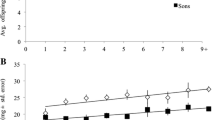Abstract
Maternal investment in offspring size and number differed between spring- and summer-emerging individual females of Megachile apicalis, a solitary multivoltine bee. Data from experimentally initiated female populations indicated that spring-emerging females produced a relatively large number of progeny but allocated a small amount of food to each, resulting in small progeny. Adult females of larger body sizes provisioned food at a greater rate than did smaller females, and this body-size effect was significant in spring-emerging females. The large body size of these females allowed them to increase the number of progeny produced under the abundant floral resources that occurred during the spring. Conversely, summer-emerging females produced fewer progeny under the diminishing resources for brood production, but allocated each with more food, producing larger progeny, most of which emerged in the spring of the following year. Field data using trap-nests also indicated the same pattern of seasonal offspring size allocation found in the experimental populations. This maternal investment strategy entails a trade-off between the size and number of progeny, so that the daughters upon emergence can best perform in their brood production under the seasonally variable environments where they reproduce.
Similar content being viewed by others
Author information
Authors and Affiliations
Rights and permissions
About this article
Cite this article
Kim, Jy., Thorp, R. Maternal investment and size-number trade-off in a bee, Megachile apicalis, in seasonal environments. Oecologia 126, 451–456 (2001). https://doi.org/10.1007/s004420000540
Received:
Accepted:
Published:
Issue Date:
DOI: https://doi.org/10.1007/s004420000540




